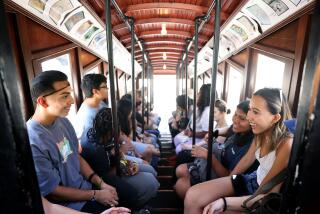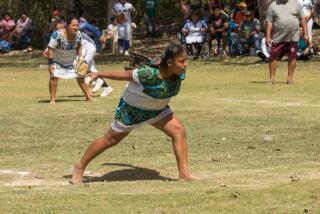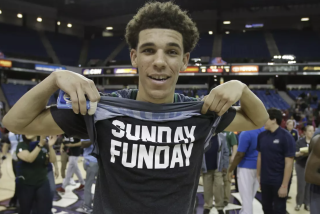Americans the Rage : In Pampas, an Ole for El Slam Dunk
SANTA FE, Argentina — On a lazy winter’s afternoon in a friendly town in the pampas, a huge black man wanders alone through streets that are foreign but are nonetheless home. Motorists gawk. Passers-by shake his hand. Wide-eyed children hurl endless questions in an alien tongue. A smiling baker offers a sweet. No charge.
It can be lonely for a stranger in the Argentine pampas, but when you are one of America’s most unlikely high-tech exports, life has its consolations.
They are found, for the most part, in crowded gymnasiums, with a bass drum banging and people screaming and the ball coming loose for a fast break, a long drive and then, up, up. A slam dunk. Just like home.
Loneliness and Joy
John Hegwood and Albert Owens and their lofty friends know both the loneliness and the joy of winter in the backlands. They are among dozens of young Americans who play basketball for pay in cowtowns with names they usually can’t pronounce. Owens, 24, from Birmingham and the University of North Alabama, is the toast of Esperanza, Argentina (population: 21,139).
Basketball is the most of it and the least of it. In coming to play basketball, the Americans also have become ambassadors of a sort among provincial folk for whom any American is a novelty, and a black man is as rare as a gaucho in blue jeans.
On and off the court, the interplay of the Americans and their Argentine host-employers is a social experiment in which both sides score surprising points.
“The only thing people here know about Americans is what they see on TV,” Hegwood, who hails from Gary, Ind., said in a recent interview. “They think all Americans are rich and carry a gun. I tell ‘em that’s wrong.”
300 Miles From Buenos Aires
Hegwood, 25, played for the University of San Francisco and is in his second season in Santa Fe, an agricultural center of 400,000 people about 300 miles northwest of Buenos Aires.
“I like it here,” he went on. “My Spanish is getting better, but even if I can’t always understand I try to answer. The people can feel the vibes. They know I’m their friend.”
Argentina is a long way down the road for players who once dreamed of fat contracts with the National Basketball Assn. But it is Latin America’s largest employer of American basketball players, according to Emma Singer, who registers traveling players for the Amateur Basketball Assn. of the U.S.A. in Colorado Springs.
Big Money in Europe
The big overseas money for American players is in West Europe, but Americans have played all over South America, except for Brazil.
“What you’ve got down in Argentina are kids who really want to play basketball,” Bill Wall, president of the amateur association, said by telephone from his office in Colorado Springs.
Alfredo Marchese, who heads the Argentine Basketball Confederation in Buenos Aires, estimates that there are 70 foreign players with Argentine teams, all Americans except for a handful of Uruguayans. The rules limit each team to two foreigners.
“The pay averages between $800 and $1,200 a month, but that’s net, plus-round trip transportation and room and board, so it’s more than it seems,” said Flor Melendez, a Puerto Rican who is in his sixth season as a coach in Argentina.
Americans have played on Argentine club teams since the late 1970s, with dramatic impact on both the quality of the game and its popularity. Strangely, the game has awakened a more avid following out in the provinces than in the capital. Some Americans play in sophisticated Buenos Aires, but most are in provincial centers like Bahia Blanca, Parana, Tucuman and Santa Fe.
The season’s big game in Santa Fe--”the Classic,” it is called--renews an old rivalry. The hometown club, Club Union, coached by Melendez, faces Almagro of nearby Esperanza. Owens and Tommy Anderson, late of Birmingham and Panhandle State, Okla., line up for Esperanza. Club Union’s big guns are Steve Harriel, 25, who learned his basketball at Compton High near Los Angeles and later played at Washington State, and 6-10 James Griffin, 26, of Fort Worth and the University of Illinois.
There are the usual 10 players on the court, but from the opening tip-off it is a contest of four against six--the four Americans will score 97 of the game’s 172 points.
“We are the only two black people in Esperanza, and we’re pretty spoiled,” Owens says, slipping on his red Esperanza shirt. “I’m having a great time. People not only invite us home for dinner, they cook special foods for us that they imagine Americans will like, things like spaghetti and meatballs and fried chicken.”
Americans, Before and Since
On the sidelines before a night game carried by two local radio stations and two local television stations, sportswriter Julio Juan Cantero of the Santa Fe newspaper El Federal notes, “In Santa Fe, the history of basketball is written in two chapters: before the Americans and since the Americans.”
Carlos Gutiez, a fan who happens also to be the Santa Fe police chief, watches with critical approval as the stands fill. There are kids everywhere.
“Basketball was dying here,” Gutiez says. “Now it is booming as a safe and exciting place for family enjoyment. What father would take his son to a soccer game anymore?”
Two years ago, according to club President Ricardo Tenerello, about 60 people watched Club Union home games. The team was mired in the second division. Then came the Americans. About 3,500 people turn out for the weeknight game with Esperanza. Club Union is fighting for first place in the 16-team national first division.
Americans Bring Crowds
“The Americans are responsible for the crowds,” referee Carlos Presas says at halftime. “I’ve seen it happen all over South America. There’s a little town ‘way back in the province called Firmat (population: 13,729) that has two first division teams and four Americans. Sometimes they both play at home on the same night, and they both sell out.”
One of Firmat’s imported stars this season has been a 24-year-old Angeleno, Leonard Goggins.
On the classic night here in Santa Fe, there is no hope for Esperanza. Owens, who is 6-5 but plays taller, is the most exciting player in town. He gets 33 points in a losing effort. Teammate Anderson is cold; he gets 15. For the winners, workmanlike Griffin and Harriel get 25 and 24, respectively.
Final score: Club Union of Santa Fe, 100; Almagro of Esperanza, 72.
“There’s good and bad about being here, but it’s inside you to play,” Harriel said later. “Once you get out on the court you forget about the bad and think about the good.”
There are obvious perils in attempting to transplant mostly urban American athletes to small towns and cities in a strange country for an eight-month season. Some of the young men don’t last.
“It’s important to try to match the players with the teams they’re going to,” said Melendez, who has moved to Santa Fe after a successful coaching career in Buenos Aires. “Big city kids might not like a small town. Generally, the players behave well. There have been some troublemakers, but they are found out right away.”
Miamian Ken Hubert and Philadelphian Ed Geiger played this season in tiny Canada de Gomez, where a single bus line serves the craftsmen of about 200 small furniture factories, but another American took one look at bigger Santiago del Estero and left.
One import had a fight about money the instant his plane arrived in Buenos Aires from the United States. He returned home, scarcely having left the airport.
Like Police Mug Shot
Marchese, thumbing through a national registration book, paused at the photo of an American player and said: “Looks like the picture was taken at Sing Sing, doesn’t it? Well, that’s exactly how he behaved. He was so outrageous, I told his club to refuse to pay his way home--let him beg the U.S. consul to do it.”
One rare white American player turned up with what Argentine doctors diagnosed as a raging case of tuberculosis. Other players, contracted through normal channels from agents in the United States, have arrived with great fanfare but only a passing acquaintance with basketball.
“Of course there have been problems, but the balance is positive both in human and sports terms,” Marchese said at his office in Buenos Aires. “After the exposure to the Americans, our (all-Argentine) national team now runs like greyhounds.”
Some of the players who arrived early now have Argentine families and careers outside basketball. Newcomers kill time and battle culture shock with various degrees of success. There are always curious Argentines who want to teach Spanish or learn English, but long hours are passed “hangin’ out, seein’ a lot of movies, shootin’ a lot of pool,” Harriel said.
Will Play in Turkey
“It gets lonely,” Griffin said. “A lot of people like us just because we’re Americans and we play basketball.”
Griffin said he will skip the upcoming second half of the Argentine season to play instead in Turkey.
For some, it is almost awesome that a skill acquired on American playgrounds should travel so far and so well.
“At first,” Hegwood said, “I said to myself, ‘Where the hell am I goin’? What kind of country? What kind of people?’ Now it’s like home for me. The people know I’m trying to help their city by playing basketball the American way. They respect me.”
As Hegwood spoke, in the lobby of a hotel where American players live, the grade-school daughter of an Argentine friend appeared, pecked Hegwood on the cheek and snuggled into his lap.
“Someday, when I have kids of my own,” Hegwood said, smiling, “I’ll get a globe and say, ‘See that place, Santa Fe? I played there. I know those people. I made friends there, and I learned how to talk with them.’ ”
More to Read
Sign up for Essential California
The most important California stories and recommendations in your inbox every morning.
You may occasionally receive promotional content from the Los Angeles Times.










